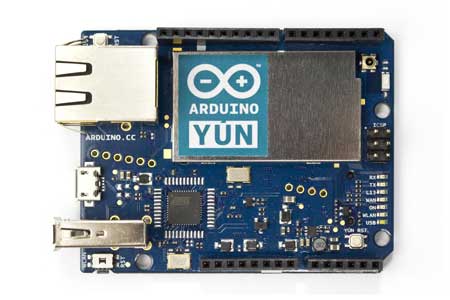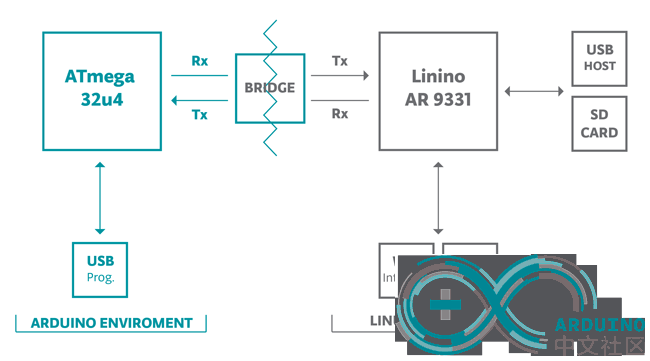Arduino Yun中文介绍
LEE大爷已经翻译了一份, 所以我这份就暂时不翻了,大家请移步:http://www.arduino.cn/thread-4208-1-1.html
翻译自Arduino.cc
再次强调!转发注明转自Arduino中文社区(http://www.arduino.cn/)
之前翻译的资料,很多网站、商家都贴去了,都不注明出处,在此强烈谴责!

概述:
Arduino yun是一个基于Atmega32u4和 Ar9331的微控制器。Ar9331运行着一个名为Linino的OpenWrt linux系统。这块控制器带有网络通信和Wifi支持,USB-A端口,Micro-SD插槽,20个输入输出引脚(其中7个可用于PWM输出,12个可用于模拟输入),16 MHz晶振, micro USB接口,ICSP接口,和一个复位按键。
NB : 某些国家不能销售wifi设备,扒拉扒拉,这段是废话......略过

Arduino Yún与其他Arduino控制器的不同在于其能通过搭载的linux系统进行通信。Yún提供了一个给力的网络计算机,除了linux 命令行外(如cURL),你还可以使用shell\python脚本来实现超爽的交互。
除开Yún板载的第二处理器,他和Leonardo一样,都使用了带有usb通信功能的Atmega32u4芯片,这使得其除了可以作为一个虚拟串口外,还可以模拟成USB鼠标键盘设备连接电脑。

这个桥接库使得两者间可以进行通信,让arduino有能力去运行shell脚本、和网络界面通信、从Ar9331接收信息。USB host、网络接口、SD卡插槽都是连接到AR9331上,没有连接到32u4上。这个桥接库也让Arduino有能力去访问这些外围设备。
悄悄更新
摘要
因为Yún有两个处理器,所以在摘要中对向两部分特性进行了列举
AVR Arduino 控制器
控制器 ATmega32u4
工作电压 5V
输入 5V
数字 I/O 20
PWM通道 7
模拟输入通道 12
每个I/O引脚直流输出能力 40 mA3.3V引脚直流输出能力 50 mA
Flash 32 KB (其中4 KB用于bootloader)
SRAM 2.5 KB
EEPROM 1 KB
时钟速率 16 MHz
Linux 处理器
处理器 Atheros AR9331
架构 MIPS @400MHz
工作电压 3.3V
网络 IEEE 802.3 10/100Mbit/s
WiFi IEEE 802.11b/g/n
USB 类型-A 2.0 Host/Device
读卡器 Micro-SD only
RAM 64 MB DDR2
Flash 16 MB
PoE 兼容 802.3af
Power
It is recommended to power the board via the micro-USB connection with 5VDC.
If you are powering the board though the Vin pin, you must supply a regulated 5VDC. There is no on-board voltage regulator for higher voltages, which will damage the board.
The Yún is also compatible with PoE power supply but in order to use this feature you need to mount a PoE module on the board or buy a preassembled one.
The power pins are as follows:
VIN. The input voltage to the Arduino board. Unlike other Arduino boards, if you are going to provide power to the board through this pin, you must provide a regulated 5V.
5V. The power supply used to power the microcontrollers and other components on the board. This can come either from VIN or be supplied by USB.
3V3. A 3.3 volt supply generated by the on-board regulator. Maximum current draw is 50 mA.
GND. Ground pins.
IOREF. The voltage at which the i/o pins of the board are operating (i.e. VCC for the board). This is 5V on the Yún.
Memory
The ATmega32u4 has 32 KB (with 4 KB used for the bootloader). It also has 2.5 KB of SRAM and 1 KB of EEPROM (which can be read and written with the EEPROM library).
The memory on the AR9331 is not embedded inside the processor. The RAM and the storage memory are externally connected. The Yún has 64 MB of DDR2 RAM and 16 MB of flash memory. The flash memory is preloaded in factory with a Linux distribution based on OpenWRT called Linino. You can change the content of the factory image, such as when you install a program or when you change a configuration file. You can return to the factory configuration by pressing the "WLAN RST" button for 30 seconds.
Input and Output
It is not possible to access the I/O pins of the Atheros AR9331. All I/O lines are tied to the 32U4.
Each of the 20 digital i/o pins on the Yún can be used as an input or output, using pinMode(), digitalWrite(), and digitalRead() functions. They operate at 5 volts. Each pin can provide or receive a maximum of 40 mA and has an internal pull-up resistor (disconnected by default) of 20-50 kOhms. In addition, some pins have specialized functions:
Serial: 0 (RX) and 1 (TX). Used to receive (RX) and transmit (TX) TTL serial data using the ATmega32U4 hardware serial capability. Note that on the Yún, the Serial class refers to USB (CDC) communication; for TTL serial on pins 0 and 1, use the Serial1 class. The hardware serials of the ATmega32U4 and the AR9331 on the Yún are connected together and are used to communicate between the two processors. As is common in Linux systems, on the serial port of the AR9331 is exposed the console for access to the system, this means that you can access to the programs and tools offered by Linux from your sketch.
TWI: 2 (SDA) and 3 (SCL). Support TWI communication using the Wire library.
External Interrupts: 3 (interrupt 0), 2 (interrupt 1), 0 (interrupt 2), 1 (interrupt 3) and 7 (interrupt 4). These pins can be configured to trigger an interrupt on a low value, a rising or falling edge, or a change in value. See the attachInterrupt() function for details. Is not recommended to use pins 0 and 1 as interrupts because they are the also the hardware serial port used to talk with the Linux processor. Pin 7 is connected to the AR9331 processor and it may be used as handshake signal in future. Is recommended to be careful of possible conflicts if you intend to use it as interrupt.
PWM: 3, 5, 6, 9, 10, 11, and 13. Provide 8-bit PWM output with the analogWrite() function.
SPI: on the ICSP header. These pins support SPI communication using the SPI library. Note that the SPI pins are not connected to any of the digital I/O pins as they are on the Uno, They are only available on the ICSP connector. This means that if you have a shield that uses SPI, but does NOT have a 6-pin ICSP connector that connects to the Yún's 6-pin ICSP header, the shield will not work.
The SPI pins are also connected to the AR9331 gpio pins, where it has been implemented in software the SPI interface. This means that the ATMega32u4 and the AR9331 can also communicate using the SPI protocol.
LED: 13. There is a built-in LED connected to digital pin 13. When the pin is HIGH value, the LED is on, when the pin is LOW, it's off.
There are several other status LEDs on the Yún, indicating power, WLAN connection, WAN connection and USB.
via - arduino中文社区